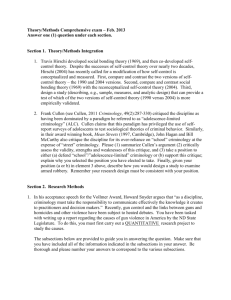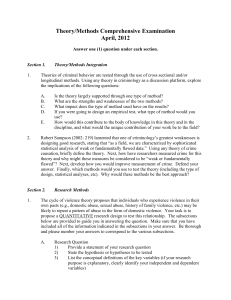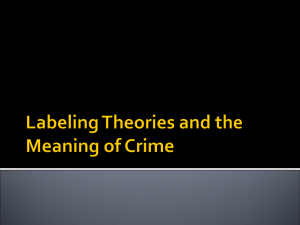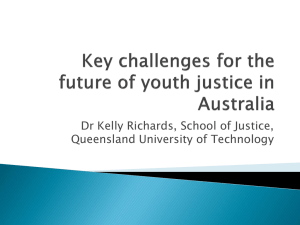Criminology Test Questions: True/False & Fill-in-Blank
advertisement
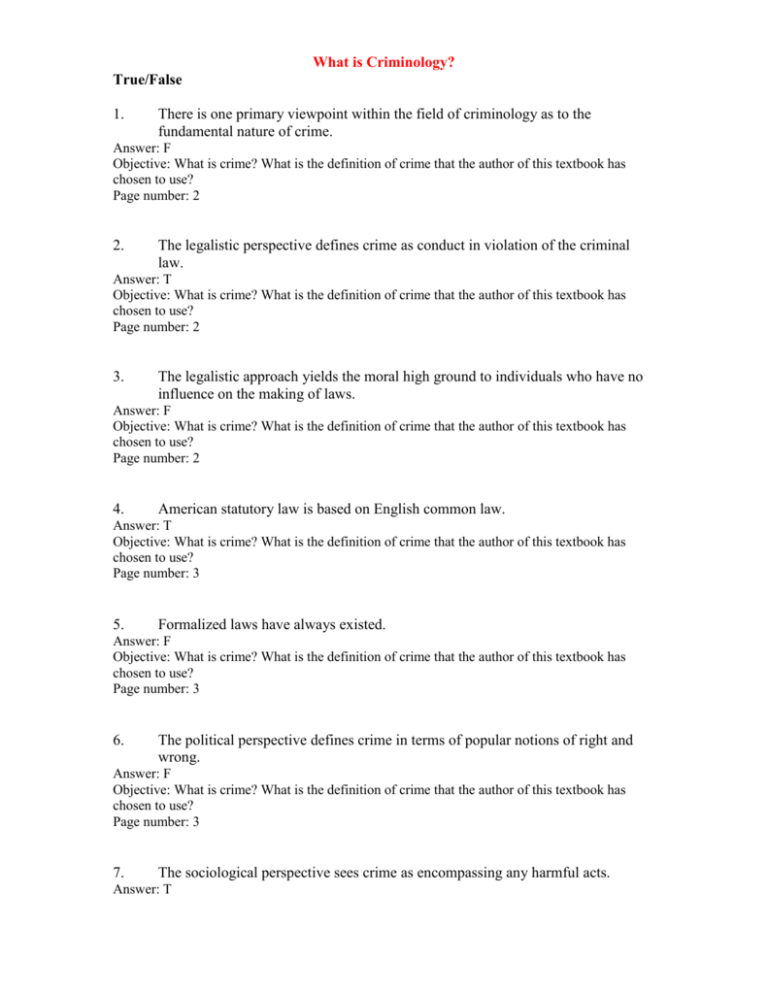
What is Criminology? True/False 1. There is one primary viewpoint within the field of criminology as to the fundamental nature of crime. Answer: F Objective: What is crime? What is the definition of crime that the author of this textbook has chosen to use? Page number: 2 2. The legalistic perspective defines crime as conduct in violation of the criminal law. Answer: T Objective: What is crime? What is the definition of crime that the author of this textbook has chosen to use? Page number: 2 3. The legalistic approach yields the moral high ground to individuals who have no influence on the making of laws. Answer: F Objective: What is crime? What is the definition of crime that the author of this textbook has chosen to use? Page number: 2 4. American statutory law is based on English common law. Answer: T Objective: What is crime? What is the definition of crime that the author of this textbook has chosen to use? Page number: 3 5. Formalized laws have always existed. Answer: F Objective: What is crime? What is the definition of crime that the author of this textbook has chosen to use? Page number: 3 6. The political perspective defines crime in terms of popular notions of right and wrong. Answer: F Objective: What is crime? What is the definition of crime that the author of this textbook has chosen to use? Page number: 3 7. The sociological perspective sees crime as encompassing any harmful acts. Answer: T Objective: What is crime? What is the definition of crime that the author of this textbook has chosen to use? Page number: 4 8. Adopting the psychological perspective of crime would greatly expand the scope of criminology. Answer: T Objective: What is crime? What is the definition of crime that the author of this textbook has chosen to use? Page number: 4 9. A unified definition of crime is simple to achieve. Answer: F Objective: What is crime? What is the definition of crime that the author of this textbook has chosen to use? Page number: 4 10. All criminal behavior is deviant. Answer: F Objective: What is deviance? How are crime and deviance similar? How do they differ? Page number: 4 11. All forms of deviant behavior are violations of the criminal law. Answer: F Objective: What is deviance? How are crime and deviance similar? How do they differ? Page number: 4 12. Some types of common and accepted behavior may be illegal. Answer: T Objective: What is deviance? How are crime and deviance similar? How do they differ? Page number: 5 13. It is possible for a behavior to be illegal in one jurisdiction but legal in another. Answer: T Objective: What is deviance? How are crime and deviance similar? How do they differ? Page number: 5 14. The pluralistic perspective is most applicable to societies characterized by a shared belief system. Answer: F Objective: Who decides what should be criminal? How are such decisions made? Page number: 6 15. A shared consensus is Basic to achieve in the United States. Answer: F Objective: Who decides what should be criminal? How are such decisions made? Page number: 6 16. There is a growing tendency to apply the term criminologist to anyone who works in the criminal justice field. Answer: F Objective: What is criminology? What do criminologists do? Page number: 8 17. A judge is a criminalist. Answer: F Objective: What is criminology? What do criminologists do? Page number: 8 18. Most criminological research results are published in journals. Answer: T Objective: What is criminology? What do criminologists do? Page number: 8 19. The attempt to understand crime predates written history. Answer: T Objective: What is criminology? What do criminologists do? Page number: 9 20. The linguistic definition of criminology focuses on criminology as a discipline. Answer: F Objective: What is criminology? What do criminologists do? Page number: 10 21. Criminology is an interdisciplinary field. Answer: T Objective: What is criminology? What do criminologists do? Page number: 11 22. Criminology is primarily a collection of theories, rather than a profession. Answer: F Objective: What is criminology? What do criminologists do? Page number: 12 23. Theoretical criminology focuses on describing crime and its occurrence. Answer: F Objective: What is criminology? What do criminologists do? Page number: 13 24. The more generalizable a theory, the more it can be applied to other situations. Answer: T Objective: What is criminology? What do criminologists do? Page number: 13 25. A general theory of crime focuses on explaining one specific type of criminal behavior. Answer: F Objective: What is criminology? What do criminologists do? Page number: 13 26. According to various professional groups, prolonged viewing of media violence can lead to emotional desensitization towards violence in real life. Answer: T Objective: How is social policy in the area of crime control determined? What role does criminological research play in the establishment of such policy? Page number: 14 27. The concern over the relationship between media violence and violent juvenile crime is an example of how criminological research may impact social policy. Answer: T Objective: How is social policy in the area of crime control determined? What role does criminological research play in the establishment of such policy? Page number: 14 28. Crime in the United States has been increasing for the past decade. Answer: F Objective: How is social policy in the area of crime control determined? What role does criminological research play in the establishment of such policy? Page number: 14 29. The social problems perspective is also known as the individual responsibility perspective. Answer: F Objective: What is the theme of this book? Upon what two contrasting viewpoints does it build? Page number: 15-16 30. The social responsibility perspective considers the cause of crime to be individual perpetrators. Answer: T Objective: What is the theme of this book? Upon what two contrasting viewpoints does it build? Page number: 16 31. The Violent Crime Control and Law Enforcement Act of 1994 was substantially influenced by the social responsibility perspective. Answer: T Objective: What is the theme of this book? Upon what two contrasting viewpoints does it build? Page number: 16 32. According to the text, crime is an isolated individual activity. Answer: F Objective: What does it mean to say that “criminal activity is diversely created and variously interpreted”? Page number: 17 33. Crime does not affect everyone equally. Answer: T Objective: What does it mean to say that “criminal activity is diversely created and variously interpreted”? Page number: 17 34. Inputs are the background causes of crime. Answer: F Objective: What does it mean to say that “criminal activity is diversely created and variously interpreted”? Page number: 17 35. Background contributions to crime are generally not very important. Answer: F Objective: What does it mean to say that “criminal activity is diversely created and variously interpreted”? Page number: 17 36. The term interpretations indicates that crime has a lasting impact on the participants and on society. Answer: T Objective: What does it mean to say that “criminal activity is diversely created and variously interpreted”? Page number: 17 37. Research suggests that there is a link between child-rearing practices and criminality in later life. Answer: T Objective: What does it mean to say that “criminal activity is diversely created and variously interpreted”? Page number: 18 38. A distinct personality is a foreground contribution by the offender. Answer: F Objective: What does it mean to say that “criminal activity is diversely created and variously interpreted”? Page number: 18 39. Proper system response may increase crime. Answer: F Objective: What does it mean to say that “criminal activity is diversely created and variously interpreted”? Page number: 18 40. The failure of a system-sponsored crime prevention program may contribute to a criminal event. Answer: T Objective: What does it mean to say that “criminal activity is diversely created and variously interpreted”? Page number: 18 41. A crime requires the victim to be an active participant. Answer: F Objective: What does it mean to say that “criminal activity is diversely created and variously interpreted”? Page number: 19 Chapter 1 Fill-in-the-Blank 1. The ___________ perspective sees crime as human conduct that violates the criminal law. Answer: legalistic Objective: What is crime? What is the definition of crime that the author of this textbook has chosen to use? Page number: 2 2. The concept of crime as a behavior that violates the criminal law derives from earlier work from criminologists such as __________. Answer: Paul Tappan Objective: What is crime? What is the definition of crime that the author of this textbook has chosen to use? Page number: 2 3. English common law did not use written __________. Answer: statutes Objective: What is crime? What is the definition of crime that the author of this textbook has chosen to use? Page number: 3 4. Seeing crime as the result of criteria that have been built into the law by powerful groups is the basis of the __________ perspective on crime. Answer: political Objective: What is crime? What is the definition of crime that the author of this textbook has chosen to use? Page number: 3 5. The sociological perspective considers crime to be a(n) __________ act. Answer: antisocial Objective: What is crime? What is the definition of crime that the author of this textbook has chosen to use? Page number: 4 6. The psychological perspective is also known as the __________ perspective. Answer: maladaptive Objective: What is crime? What is the definition of crime that the author of this textbook has chosen to use? Page number: 4 7. The __________ perspective suggests that behaviors should be criminalized when members of society generally agree that such laws are necessary. Answer: consensus Objective: What is crime? What is the definition of crime that the author of this textbook has chosen to use? Page number: 6 8. The pluralistic perspective of crime recognizes the importance of __________ in modern societies. Answer: diversity Objective: Who decides what should be criminal? How are such decisions made? Page number: 6-8 9. A __________ specializes in the collection and examination of the physical evidence of crime. Answer: criminalist Objective: What is criminology? What do criminologists do? Page number: 8 10. The official publication of the Academy of Criminal Justice Sciences is__________. Answer: Justice Quarterly Objective: What is criminology? What do criminologists do? Page number: 8 11. Preliterate people appear to have explained deviant behavior by reference to __________. Answer: spirit possession Objective: What is criminology? What do criminologists do? Page number: 9 12. The term criminology was coined by __________. Answer: Paul Topinard Objective: What is criminology? What do criminologists do? Page number: 10 13. __________ definitions of criminology focus on criminology as a field of study or body of knowledge. Answer: Disciplinary Objective: What is criminology? What do criminologists do? Page number: 10 14. __________ is an interdisciplinary profession built around the scientific study of crime and criminal behavior. Answer: Criminology Objective: What is criminology? What do criminologists do? Page number: 11 15. In addition to being a field of study or a collection of theories, criminology is also a __________. Answer: profession Objective: What is criminology? What do criminologists do? Page number: 12 16. Criminology contributes to the discipline of __________. Answer: criminal justice Objective: What is criminology? What do criminologists do? Page number: 12 17. Criminology gives prominence to questions about the __________. Answer: causes of criminality Objective: What is criminology? What do criminologists do? Page number: 12 18. __________ theories provide potentially wider explanatory power. Answer: Integrated Objective: What is criminology? What do criminologists do? Page number: 13 19. American crime rates have been __________ steadily during the past ten years. Answer: decreasing Objective: How is social policy in the area of crime control determined? What role does criminological research play in the establishment of such policy? Page number: 14 20. Proponents of the social problems perspective advocates solutions based on a __________ model. Answer: public health Objective: What is the theme of this book? Upon what two contrasting viewpoints does it build? Page number: 15 21. The social problems perspective is characteristic of what social scientists term a __________ approach. Answer: macro Objective: What is the theme of this book? Upon what two contrasting viewpoints does it build? Page number: 16 22. The social responsibility perspective is also known as the __________ responsibility perspective. Answer: individual Objective: What is the theme of this book? Upon what two contrasting viewpoints does it build? Page number: 16 23. Background causes of crime are known as __________. Answer: contributions Objective: What does it mean to say that “criminal activity is diversely created and variously interpreted”? Page number: 17 24. Personal life experiences are __________ features. Answer: background Objective: What does it mean to say that “criminal activity is diversely created and variously interpreted”? Page number: 17 25. A specific intent is an example of a __________ contribution to crime by the offender. Answer: foreground Objective: What does it mean to say that “criminal activity is diversely created and variously interpreted”? Page number: 18 26. An innocent victim killed outside his/her home by random gunfire from a driveby shooting is a __________ participant in the crime. Answer: passive Objective: What does it mean to say that “criminal activity is diversely created and variously interpreted”? Page number: 19 27. The primacy of sociology emphasizes that crime is a __________. Answer: social phenomenon Objective: What discipline has contributed the most to theoretical understandings of crime causation over the past century? Page number: 21 Chapter 1 Multiple Choice 1. When defining crime, which of the following is not one of the definitional perspectives found in contemporary criminology? a. Political b. Psychological c. Environmental d. Sociological Answer: C Objective: What is crime? What is the definition of crime that the author of this textbook has chosen to use? Page number: 2 2. “Human conduct that is in violation of the criminal laws of a state, the federal government, or a local jurisdiction that has the power to make such laws” is a definition of a. criminology. b. crime. c. criminal. d. deviance. Answer: B Objective: What is crime? What is the definition of crime that the author of this textbook has chosen to use? Page number: 2 3. The legalistic approach would suggest that crime is socially relative in the sense that is created by a. legislative activity. b. social mores. c. the democratic process. d. human conduct. Answer: A Objective: What is crime? What is the definition of crime that the author of this textbook has chosen to use? Page number: 2-3 4. Which of the following is not a problem with the legislative perspective? a. It yields the moral high ground to powerful individuals who can influence the making of laws. b. It insists that the nature of crime cannot be separated from the nature of law. c. It fails to recognize that formalized laws have not always existed. d. They are all problems with the legislative perspective. Answer: D Objective: What is crime? What is the definition of crime that the author of this textbook has chosen to use? Page number: 2-3 5. In a __________ state, an individual may be prosecuted for violating traditional notions of right and wrong, even though no violation of written law occurred. a. statutory law b. common law c. criminalized d. none of the above Answer: B Objective: What is crime? What is the definition of crime that the author of this textbook has chosen to use? Page number: 3 6. According to John F. Galliher, legal definitions of criminality are arrived at through a __________ process. a. sociological b. mainstream c. political d. psychological Answer: C Objective: What is crime? What is the definition of crime that the author of this textbook has chosen to use? Page number: 3 7. The belief that crime is the result of criteria that have been built into the law by powerful groups is the basis of the __________ perspective on crime. a. b. c. d. legal political sociological psychological Answer: B Objective: What is crime? What is the definition of crime that the author of this textbook has chosen to use? Page number: 3 8. The belief that crime is an antisocial act of such a nature that repression is necessary to preserve the existing system of society is the basis of the __________ perspective on crime. a. legal b. political c. sociological d. psychological Answer: C Objective: What is deviance? How are crime and deviance similar? How do they differ? Page number: 4 9. Ron Classen sees crime primarily as a. a violation of a law. b. an offense against human relationships. c. a form of social maladjustment. d. problem behavior. Answer: B Objective: What is deviance? How are crime and deviance similar? How do they differ? Page number: 4 10. The psychological perspective sees crime primarily as a. a violation of a law. b. an offense against human relationships. c. a form of social maladjustment. d. problem behavior. Answer: D Objective: What is deviance? How are crime and deviance similar? How do they differ? Page number: 4 11. Which of the following statements about deviance and crime is/are true? a. All deviant behavior is criminal. b. All criminal behavior is deviant. c. Deviant behavior and criminal behavior overlap. d. Deviant behavior and criminal behavior are identical. Answer: C Objective: What is deviance? How are crime and deviance similar? How do they differ? Page number: 4-5 12. Because you were late for this exam, you exceeded the speed limit by about 10 to 15 miles per hour while driving to class. This is an example of behavior that is a. deviant but not criminal. b. criminal but not deviant. c. both deviant and criminal. d. neither deviant nor criminal. Answer: B Objective: What is deviance? How are crime and deviance similar? How do they differ? Page number: 5 13. The pluralistic perspective suggests that behaviors are typically criminalized through a. general agreement of members of society. b. the existence of shared norms and values. c. a political process. d. none of the above Answer: C Objective: What is deviance? How are crime and deviance similar? How do they differ? Page number: 7 14. The gun control debate is an example of the __________ perspective. a. consensus b. psychological c. sociological d. pluralistic Answer: D Objective: What is deviance? How are crime and deviance similar? How do they differ? Page number: 7 15. One who studies crime, criminals, and criminal behavior is called a a. scientist. b. criminal justice professional. c. criminologist. d. criminalism. Answer: C Objective: What is criminology? What do criminologists do? Page number: 8 16. The official publication of the American Society of Criminology is a. Criminology. b. Justice Quarterly. c. The Journal of Quantitative Criminology. d. Crime and Delinquency. Answer: A Objective: What is criminology? What do criminologists do? Page number: 8 17. Which of the following jobs probably would not fall within the field of criminalistics? a. Forensics examiner b. Polygraph operator c. Fingerprint examiner d. Correctional officer Answer: D Objective: What is criminology? What do criminologists do? Page number: 8 18. A police officer or probation officer is best described as a a. criminologist. b. criminalist. c. criminal justice professional. d. none of the above Answer: C Objective: What is criminology? What do criminologists do? Page number: 8 19. An academic or research criminologist generally holds a __________ degree. a. doctoral b. law c. medical d. none of the above Answer: A Objective: What is criminology? What do criminologists do? Page number: 8 20. Criminologists work for a. universities and other academic institutions. b. federal research agencies. c. private research organizations. d. all of the above Answer: D Objective: What is criminology? What do criminologists do? Page number: 8 21. The number of personnel employed by private security agencies today is __________ that of public law enforcement agencies. a. half b. equal to c. twice d. four times Answer: C Objective: What is criminology? What do criminologists do? Page number: 8 22. The __________ definition of criminology literally defines the term as the study of crime. a. linguistic b. disciplinary c. causative d. scientific Answer: A Objective: What is criminology? What do criminologists do? Page number: 10 23. Which of the following is a disciplinary definition of criminology? a. Criminology is the body of knowledge regarding the social problem of crime. b. Criminology is the scientific study of crime. c. Criminology is the study of the causes of crime. d. Criminology is the scientific study of crime, criminals, and criminal behavior. Answer: A Objective: What is criminology? What do criminologists do? Page number: 10 24. Which of the following is not one of the three principal divisions of criminology proposed by Edwin Sutherland? a. The sociology of law b. The scientific analysis of the causes of crime. c. Crime control d. The study of the criminal justice system Answer: D Objective: What is criminology? What do criminologists do? Page number: 10-11 25. __________ definitions focus on criminology’s role in uncovering the underlying causes of crime. a. Disciplinary b. Causative c. Scientific d. None of the above Answer: B Objective: What is criminology? What do criminologists do? Page number: 11 26. The field of study that is concerned primarily with the causes and consequences of crime is a. criminology. b. criminal justice. c. criminality. d. criminalistics. Answer: A Objective: What is criminology? What do criminologists do? Page number: 11 27. Criminology is a. a field of study. b. a collection of theories. c. a profession. d. All of the above Answer: D Objective: What is criminology? What do criminologists do? Page number: 12 28. Criminal justice emphasizes a. the application of the criminal law. b. the study of the components of the criminal justice system. c. both a and b d. none of the above Answer: C Objective: What is criminology? What do criminologists do? Page number: 12 29. A(n) __________ theory of crime is one that attempts to explain all or most forms of criminal conduct through a single, overarching approach. a. complete b. unicausal c. integrated d. general Answer: D Objective: What is criminology? What do criminologists do? Page number: 13 30. A(n) __________ theory does not necessarily attempt to explain all criminality. a. general b. integrated c. unicausal d. complete Answer: B Objective: What is criminology? What do criminologists do? Page number: 13 31. According to various professional groups, violence in television, music, video games, and movies a. may lead to increased levels of violent behavior among children. b. may lead to decreased levels of violent behavior among children. c. may have no effect on levels of violent behavior among children. d. may lead to emotional sensitization toward violence in real life. Answer: A Objective: How is social policy in the area of crime control determined? What role does criminological research play in the establishment of such policy? Page number: 14 32. According to a recent Gallup poll, the majority of respondents believed that crime in the United States is a. more prevalent than it was a year ago. b. less prevalent than it was a year ago. c. occurring at about the same rate as in the previous year. d. fluctuating wildly. Answer: A Objective: How is social policy in the area of crime control determined? What role does criminological research play in the establishment of such policy? Page number: 15 33. The social problems perspective holds that crime is a. a manifestation of underlying social problems. b. chosen by individual perpetrators. c. not going to be solved by social programs. d. none of the above Answer: A Objective: What is the theme of this book? Upon what two contrasting viewpoints does it build? Page number: 15 34. Which of the following crime reduction or prevention strategies is most characteristic of the social problems perspective? a. A government-funded initiative to enhance educational opportunities among low-income individuals b. A move to broaden police powers by increasing the number of exceptions to the Exclusionary Rule c. Rewriting state statutes to increase the severity of punishment for violent offenders, such as three-strikes laws d. All of the above Answer: A Objective: What is the theme of this book? Upon what two contrasting viewpoints does it build? Page number: 15 35. Which of the following statements about the social problems perspective is not true? a. b. c. d. It suggests that crime is a symptom of underlying social problems such as poverty and discrimination. It emphasizes the development of social and educational opportunities as a way of dealing with the crime problem. It emphasizes crime prevention efforts such as harsher sentences and the development of rehabilitation programs. It sees crime as a public health problem as well as a criminal justice problem. Answer: C Objective: What is the theme of this book? Upon what two contrasting viewpoints does it build? Page number: 15-16 36. The social responsibility perspective is affiliated with __________ theory. a. routine activities b. culture conflict c. rational choice d. social learning Answer: C Objective: What is the theme of this book? Upon what two contrasting viewpoints does it build? Page number: 16 37. Which of the following recent developments in national crime control policy was not substantially influenced by the social responsibility perspective? a. The increase in the number of capital crimes under federal law b. The enactment of a federal three-strikes law c. The increase in penalties for offenders convicted of drug trafficking d. The development of the Job Corps to reduce unemployment by encouraging the development of job skills Answer: D Objective: What is the theme of this book? Upon what two contrasting viewpoints does it build? Page number: 16 38. The more immediate propensities and predispositions of the actors involved in the crime are known as a. contributions. b. interpretations. c. inputs. d. outputs. Answer: C Objective: What does it mean to say that “criminal activity is diversely created and variously interpreted”? Page number: 17 39. Which of the following is not a foreground contribution by an offender? a. A particular motivation b. c. d. A peculiar biology A specific intent A drug-induced state of mind Answer: B Objective: What does it mean to say that “criminal activity is diversely created and variously interpreted”? Page number: 18 40. The __________ contributes to the criminal event by failing to prevent criminal activity. a. victim b. offender c. criminal justice system d. general public Answer: C Objective: What does it mean to say that “criminal activity is diversely created and variously interpreted”? Page number: 18 41. Which of the following is not an immediate input provided by the justice system that may enhance or reduce the likelihood of criminal occurrences? a. The presence or absence of police officers b. A prison that acts as a crime school c. Police response time to a crime scene d. The availability or lack of official assistance Answer: B Objective: What does it mean to say that “criminal activity is diversely created and variously interpreted”? Page number: 18 42. A victim may actively contribute to his/her own victimization through the appearance of a. defensiveness. b. exposure. c. defenselessness. d. precipitation. Answer: C Objective: What does it mean to say that “criminal activity is diversely created and variously interpreted”? Page number: 19 43. _________ is the process by which one acquires the cultural values of one’s society. a. Socialization b. Integration c. Social relativity d. Criminalistics Answer: A Objective: What does it mean to say that “criminal activity is diversely created and variously interpreted”? Page number: 19 44. A large number of modern criminological theories fall within the framework of _________ theory. a. psychological b. legal c. economic d. sociological Answer: D Objective: What discipline has contributed the most to theoretical understandings of crime causation over the past century? Page number: 21 Answer Key Chapter 1 True/False 1. FALSE 2. TRUE 3. FALSE 4. TRUE 5. FALSE 6. FALSE 7. TRUE 8. TRUE 9. FALSE 10. FALSE 11. FALSE 12. TRUE 13. TRUE 14. FALSE 15. FALSE 16. FALSE 17. FALSE 18. TRUE 19. TRUE 20. FALSE 21. TRUE 22. FALSE 23. FALSE 24. TRUE 25. FALSE 26. TRUE 27. TRUE 28. FALSE 29. FALSE 30. TRUE 31. TRUE 32. FALSE 33. TRUE 34. FALSE 35. FALSE 36. TRUE 37. TRUE 38. FALSE 39. FALSE 40. TRUE 41. FALSE Chapter 1 Fill-in-the-Blank 1. legalistic 2. Paul Tappan 3. statutes 4. political 5. antisocial 6. maladaptive 7. consensus 8. diversity 9. criminalist 10. Justice Quarterly 11. spirit possession 12. Paul Topinard 13. Disciplinary 14. Criminology 15. profession 16. criminal justice 17. causes of criminality 18. Integrated 19. decreasing 20. public health 21. macro 22. individual 23. contributions 24. background 25. foreground 26. passive 27. social phenomenon Chapter 1 Multiple Choice 1. C 2. B 3. A 4. D 5. B 6. C 7. B 8. C 9. B 10. D 11. C 12. B 13. C 14. D 15. C 16. A 17. D 18. C 19. A 20. D 21. C 22. A 23. A 24. D 25. B 26. A 27. D 28. C 29. D 30. B 31. A 32. A 33. A 34. A 35. C 36. C 37. D 38. C 39. B 40. C 41. B 42. C 43. A 44. D



